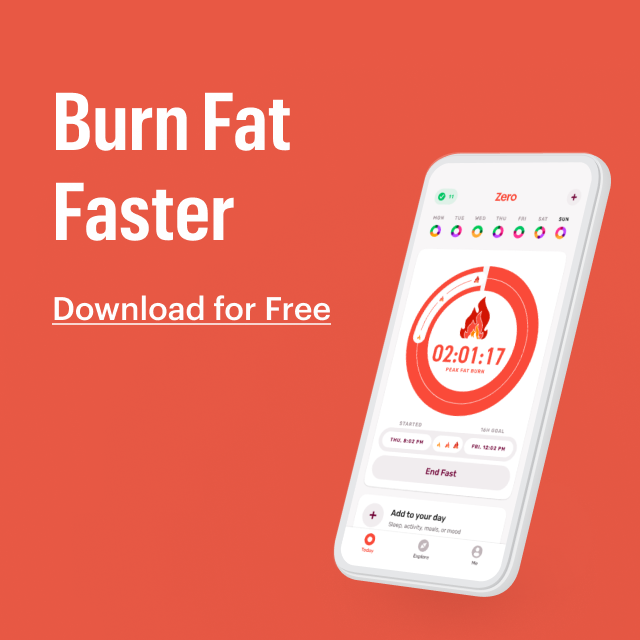Written and medically reviewed by Rich LaFountain, PhD
If you want to live longer, look no further than your daily habits. What (and when) we eat, how much we move, and the environment we surround ourselves in play critical roles in our overall longevity and quality of life.
To extend your lifespan — and the amount of time you have to enjoy it — consider adding these five practical, science-backed habits to your day-to-day. Grab a checklist and get to reading!

#1. Ketogenic Diet (KD) + Intermittent Fasting (IF)
The ketogenic diet is an extremely low-carb diet that, in many ways, mimics the physiology of fasting. Both keto and fasting aid in reducing insulin levels, thereby causing your metabolism to shift away from glucose in favor of fat burning and ketone production. Additionally, combining KD + IF has been shown to promote weight loss, enhance metabolic health, and improve insulin resistance.
Clinically, KD + IF may also help some patients ameliorate diabetes. In one case study, a 57-year-old woman was able to reverse type 2 diabetes within a mere four months. Remarkably, she even normalized her glucose levels without any medication.
Of course, if you’re thinking of making any dietary changes, we recommend consulting with your doctor or a registered dietician. A qualified professional will help you navigate the ins and outs of your new lifestyle change so you can maximize its benefits — and possibly pick up some delicious recipes along the way!
#2. Mediterranean Diet (MD) + Intermittent Fasting (IF)
Feeling like keto isn’t right for you? No problem! The Mediterranean diet is a popular, evidence-based diet associated with better health and longevity. In a 2019 study, participants that followed a MD + IF protocol saw drops in body weight (4.8%), fat mass (7.3%), visceral fat mass (11.7%), and waist circumference (5.1%).
According to a 2020 review of cumulative evidence, daily fasts of 12 to 16 hours are pivotal in the success of this strategy, and it is believed that MD + IF may even address the leading cause of mortality worldwide — cardiovascular disease.
Similarly to KD + IF, each strategy is solid on its own, but, together, they make for a winning combination that addresses health in the short and long-term. Aside from consulting a registered dietician, we also recommend having a few gallons of extra virgin olive oil handy just in case.
#3. Zone 2 Physical Activity
We’ve talked about calories in, but what about calories out? One of the best things you can do for gains in longevity and metabolic health is incorporate zone 2 — or low-to-moderate-intensity — physical activity into your exercise routine.
Need some inspiration? Try these zone-2-approved exercises:
- Fast walking or slow jogging
- Light rowing or swimming
- Biking (Indoors or outdoors)
Want to make sure you’re in zone 2? Look for the telltale signs:
- Heart rate is at 60 to 80% of its max (220 – your age = max heart rate)
- Perceived difficulty is at 3 to 6 on a 1 to 10 scale
- Your breathing is fast, but you can still carry a conversation in short, semi-muffled sentences
Healthy adults over the age of 18 should participate in a minimum of 30 to 45 minutes of zone 2 physical activity at least 3 to 5 days per week. To make the most out of your fitness habit, try pairing it with — you guessed it — intermittent fasting!
#4. Resistance Training
Your muscles are physiological superstars. Aside from supporting your posture, breathing, and locomotion, they also act as a nutrient storage facility and metabolism regulator. If longevity is important to you, then preserving bodily autonomy should be top of mind — life expectancy drops significantly once personal independence is lost.
Studies demonstrate a link between larger, stronger muscles and increased health and lifespan. Just 6 months of resistance training in people with an average age of 68 results in mitochondrial characteristics similar to 24-year-olds.
Resistance training is a great fit for almost everyone, but getting started with (or getting back into) an exercise regimen can be notoriously challenging. The good news is that it’s never too late, and even two sessions of resistance training of 60 minutes or less are enough to help protect your metabolic health and reduce the risk of chronic, age-related diseases.
#5. Layered Habits & Community
There’s no way around it: Your environment influences and reinforces your habits whether they’re healthy or unhealthy. Blue zones — regions around the world with particularly long life expectancy — seem to illustrate this fact.
Blue zones incorporate a mixture of shared daily habits and living behaviors, like nutritious meals and physical activity throughout the day in the form of work, chores, and lots of walking. Longevity, by definition, is a paradox that includes the biological expression of age along with simple routines that are woven into the fabric of our communities.
If you don’t happen to live in a blue zone — there are only five of them, after all — you can still try to create a supportive environment. Get friends and family involved, find walkable spots in your area, practice mindful meals, join the Zero Instagram community, and stay flexible and creative in your quest for longevity!
When it comes down to it, your lifestyle is a summation of your habits and conscious behaviors. Buildings habits is hard, and it can often feel like you’re going against the grain of what feels normal or natural to you — and that’s because you are! Be patient as you restructure your life for the long haul, and know that this is one journey worth taking.
References
Robinson AM, Williamson DH. Physiological roles of ketone bodies as substrates and signals in mammalian tissues. Physiol Rev. 1980 Jan;60(1):143-87. doi: 10.1152/physrev.1980.60.1.143. PMID: 6986618.
Arbour MW, Stec M, Walker KC, Wika JC. Clinical Implications for Women of a Low-Carbohydrate or Ketogenic Diet With Intermittent Fasting. Nurs Womens Health. 2021 Apr;25(2):139-151. doi: 10.1016/j.nwh.2021.01.009. PMID: 33838849.
Freire R. Scientific evidence of diets for weight loss: Different macronutrient composition, intermittent fasting, and popular diets. Nutrition. 2020 Jan;69:110549. doi: 10.1016/j.nut.2019.07.001. Epub 2019 Jul 4. PMID: 31525701.
Lichtash C, Fung J, Ostoich KC, Ramos M. Therapeutic use of intermittent fasting and ketogenic diet as an alternative treatment for type 2 diabetes in a normal weight woman: a 14-month case study. BMJ Case Rep. 2020 Jul 7;13(7):e234223. doi: 10.1136/bcr-2019-234223. PMID: 32641437; PMCID: PMC7342268.
Dernini S, Berry EM. Mediterranean Diet: From a Healthy Diet to a Sustainable Dietary Pattern. Front Nutr. 2015 May 7;2:15. doi: 10.3389/fnut.2015.00015. PMID: 26284249; PMCID: PMC4518218.
Jimenez, A. M., Oliva, S. L., Vilar, E. G., de Cuevillas, B., Morais Moreno, M. D. C., Gabella de Prado, J., … & Mauro Martin, I. S. (2019). The Mediterranean diet pattern with intermittent semi-fasting may facilitate weight loss: randomised controlled trial. Mediterranean Journal of Nutrition and Metabolism, 12(2), 153-161.
O’Keefe JH, Torres-Acosta N, O’Keefe EL, Saeed IM, Lavie CJ, Smith SE, Ros E. A Pesco-Mediterranean Diet With Intermittent Fasting: JACC Review Topic of the Week. J Am Coll Cardiol. 2020 Sep 22;76(12):1484-1493. doi: 10.1016/j.jacc.2020.07.049. PMID: 32943166.
Şahin B, İlgün G. Risk factors of deaths related to cardiovascular diseases in World Health Organization (WHO) member countries. Health Soc Care Community. 2022 Jan;30(1):73-80. doi: 10.1111/hsc.13156. Epub 2020 Sep 9. PMID: 32909378.
Norton K, Norton L, Sadgrove D. Position statement on physical activity and exercise intensity terminology. J Sci Med Sport. 2010 Sep;13(5):496-502. doi: 10.1016/j.jsams.2009.09.008. Epub 2009 Dec 10. PMID: 20005170.
Aoyagi Y, Shephard RJ. Aging and muscle function. Sports Med. 1992 Dec;14(6):376-96. doi: 10.2165/00007256-199214060-00005. PMID: 1470791.
McLeod M, Breen L, Hamilton DL, Philp A. Live strong and prosper: the importance of skeletal muscle strength for healthy ageing. Biogerontology. 2016 Jun;17(3):497-510. doi: 10.1007/s10522-015-9631-7. Epub 2016 Jan 20. PMID: 26791164; PMCID: PMC4889643.
Melov S, Tarnopolsky MA, Beckman K, Felkey K, Hubbard A. Resistance exercise reverses aging in human skeletal muscle. PLoS One. 2007 May 23;2(5):e465. doi: 10.1371/journal.pone.0000465. PMID: 17520024; PMCID: PMC1866181.
Hasten DL, Pak-Loduca J, Obert KA, Yarasheski KE. Resistance exercise acutely increases MHC and mixed muscle protein synthesis rates in 78-84 and 23-32 yr olds. Am J Physiol Endocrinol Metab. 2000 Apr;278(4):E620-6. doi: 10.1152/ajpendo.2000.278.4.E620. PMID: 10751194.
Fisher JP, Steele J, Gentil P, Giessing J, Westcott WL. A minimal dose approach to resistance training for the older adult; the prophylactic for aging. Exp Gerontol. 2017 Dec 1;99:80-86. doi: 10.1016/j.exger.2017.09.012. Epub 2017 Sep 28. PMID: 28962853.
Fastame, M. C., Ruiu, M., & Mulas, I. (2022). Hedonic and Eudaimonic well-being in late adulthood: Lessons from Sardinia’s Blue Zone. Journal of Happiness Studies, 23(2), 713-726.
Jylhävä J, Pedersen NL, Hägg S. Biological Age Predictors. EBioMedicine. 2017 Jul;21:29-36. doi: 10.1016/j.ebiom.2017.03.046. Epub 2017 Apr 1. PMID: 28396265; PMCID: PMC5514388.
- Debunking 3 Myths Around Fasting and Thyroid Health - April 15, 2024
- Breaking Down Fast Breakers: How to Tell If Something Will Break Your Fast - March 4, 2024
- GLP-1s and Weight-Loss Medications vs. Lifestyle Interventions: What’s Right for You - February 5, 2024






